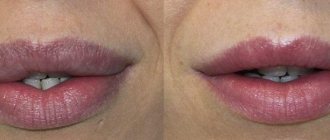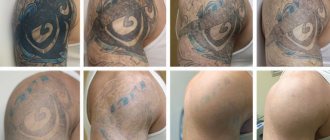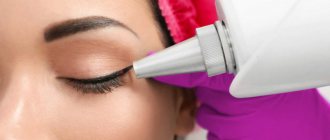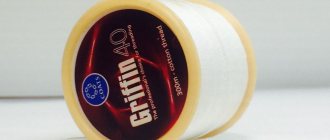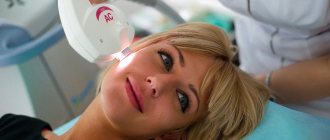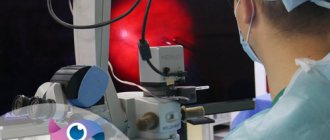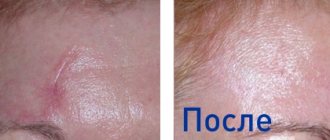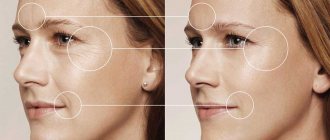The electrocoagulation procedure involves removing skin lesions by cauterizing them using a special device that generates an electric current. The procedure takes only a few minutes when it comes to coagulation of warts, moles and papillomas. However, this technique has a number of distinctive aspects and advantages, which include:
- absolute safety for the patient’s facial skin;
- excellent aesthetic effect without scars or any other traces of removal;
- high degree of efficiency and minimal time required to carry out this procedure;
- no wounds or bleeding;
- the ability to adjust the depth of impact on the problem area to achieve the optimal effect;
- affordable cost of the procedure.
Among the general disadvantages that are inherent not only in coagulation, but also in any other procedure, only minor pain or discomfort during the procedure can be attributed.
Electrocoagulation
This method of removing skin growths is the oldest. It has been used since the mid-20th century. And at the same time, the mere fact that electrocoagulation has reached our days already speaks of its practicality. Getting rid of papillomas, moles, calluses, etc. is carried out by point cauterization, and the device itself resembles a soldering iron. It welds the affected area of the skin or mucous membrane, after which a crust forms at the site of the removed growth and next to it, which falls off over time. The new tissues in the treated area are initially thinner and lighter in color compared to the neighboring ones, but soon they take on a normal appearance.
Please note: this procedure requires prior anesthesia. If the neoplasm is small, after electrocoagulation there will not be the slightest trace of it. After removing a large growth, a small scar will remain, which, however, can be easily disguised.
After getting rid of the tumor, the skin in the correction area must be treated every day until the crust falls off. Your doctor will tell you how to care for this area.
Electrocoagulation and correction of blood vessels in the facial area
This procedure allows you to get rid of dilated and highly visible capillaries on the face. The manipulation is carried out using devices that generate alternating low-frequency electric current. Often, such problem areas of facial skin require only one session of electrocoagulation. If necessary, the cosmetologist prescribes additional procedures.
This technique is carried out in several main stages:
- First, a specific area of skin is treated with a disinfectant solution, after which it is numbed with lidocaine.
- Next, the vessels are cauterized using needle conductors.
- At the end of the session, the treated skin surface is treated with a disinfectant. Products containing corticosteroids are applied to the skin, which instantly relieve inflammation and avoid subsequent complications.
Method of removing condylomas
Condyloma is a papilloma of the genital organs, which has the shape of a cone and is a skin growth. Such neoplasms appear as a result of sexually transmitted viral infections. In modern practice, there are five effective methods of combating such neoplasms:
- surgical correction;
- laser;
- radiosurgery;
- cryodestructive method;
- electrocoagulation method.
In the most difficult cases, electrocoagulation is the most effective and least dangerous way to remove condylomas. In this case, the procedure can be performed under local anesthesia due to the high sensitivity of the treated area. The procedure is carried out within twenty minutes, and recovery after it can take up to 2 weeks.
Electrocoagulation and gynecology
One of the most effective procedures for eliminating tumors and erosions of the cervix is gynecological electrocoagulation. This is the safest method. The procedure is performed under local anesthesia. Indications for such a procedure include:
- papillomavirus;
- erosion or pseudo-erosion of the cervix;
- endometriosis of subepthelial type;
- cervicitis;
- bleeding caused by diagnostic tests.
The rehabilitation period after gynecological electrocoagulation is approximately one to two weeks.
Electrocoagulation or laser: which is better?
Advantages and disadvantages of electrocoagulation
If you want to minimize the cost of a cosmetic procedure, use the classic method of getting rid of growths. True, when removing a tumor using electrocoagulation, neighboring tissues will be slightly affected.
Advantages and disadvantages of laser exposure
This is a more modern method. It costs more, but it is carried out precisely and is carried out faster. This applies to both the procedure itself and the healing of tissue after it. As mentioned above, neighboring healthy cells will not be damaged. And most importantly, after electrocoagulation, scars will not appear on the damaged area even after removing large growths.
In addition to the high cost of the procedure, laser coagulation has two more disadvantages, one of which is of fundamental importance. Having eliminated the external imperfection, you will not be able to submit the tumor for analysis, since there will be nothing to send: the tissue will be completely destroyed. This will not happen with electrocoagulation. In addition, not every volumetric growth can be removed with a laser. And if you have dark skin, using a modern device can cause burns.
Conclusion:
There is no clear opinion about what is better to remove moles: electrocoagulation or laser. You choose the answer to this question yourself.
Laser coagulation
Laser removal of tumors is less traumatic, which allows it to be used on mucous membranes, around the eyes, and on the eyelids. There are no scars left after the procedure. Since nevi are burned out completely, a biopsy is performed before removal. Healing time is about a week. Laser has fewer contraindications.
Laser coagulation is recommended for the removal of flat, deep tumors with a large diameter. This is the only option when the mole is located in sensitive or hard-to-reach places, between the folds of the skin.
Features of electrocoagulation
We examined the essence of such a method as electrocoagulation. What is this, we hope you understand. It remains to understand how the procedure is carried out. First of all, you should remember that only specialized clinics and beauty salons provide such services. Such procedures are not carried out at home. To remove tumors using a similar method, electrodes are used.
The method of electrocoagulation, which is popular today, is carried out using an inactive electrode made in the form of a lead plate. Foil can also be used for this procedure. An inactive electrode is placed under the thigh, buttock and other areas of the body, and the active one is used for manipulation. The latter can be of completely different shapes. This can be a ball, a curved or straight loop, a needle, a knife, and so on. Both electrodes are connected to a device that operates in several modes and depending on the waves generated, and they are:
Long. They usually have a cutting effect. Most often, this mode is used to dissect subcutaneous structures and skin. In addition, medical cosmetology uses this method to cut off and remove tumors that are pathological in nature. Most often, this method removes warts and moles that protrude above the surface of the skin and have a stalk.
Short. They have a cauterizing effect. Medical cosmetology uses such waves for the destruction of flat birthmarks, telangiectasia, hemangiomas, papillomas, tattoos and genital warts.
Electrocoagulation is an effective method of influencing unwanted tissue formations with the goal of removal. The method is preferred by doctors and patients due to the ability to influence the affected area with a controlled depth. Electrocoagulation is one of the surgical methods for treating the disease.
Skin care after the procedure
After electrocoagulation, the doctor will prescribe an individual care regimen for the removal site. But we can give general recommendations:
- For the first 7-12 days, the wound is covered with a crust that cannot be removed. Underneath it, the process of restoration of the epidermis occurs. During this period, you should not apply cosmetics or wash the area.
- The crust is usually treated with a 5% solution of potassium permanganate.
- The skin area should be protected from friction, injury and sunlight. It is recommended to use sunscreen with a high SPF factor (at any time of the year).
Removal of warts by electrocoagulation: how long does it take for the wound to heal?
The rehabilitation period is 10-14 days. Immediately after excision by electrocoagulation, the treated area reacts with redness and swelling, which disappear within a day. On the second day, a scab forms - a crust that protects the wound from dirt and infection.
You should not wet the scab or try to tear it off before it falls off on its own. Doctors do not recommend using a patch to mask or protect the excised area—the process of crust formation does not occur.
To create the necessary conditions for the formation of a scab, forget about creams, ointments, and other cosmetic emollients and moisturizers for a while. After a wart has been removed by electrocoagulation, you should not wet the wound for at least the first day.
If the wound gets infected, pus will form under the crust. In this case, you need to consult your doctor - he will soften the scab with peroxide or furatsilin and carefully remove it to clean the wound.
Method of electrocoagulation of condylomas of the external genitalia
Electrocoagulation is based on the impact of electrical discharges on the affected area. Due to this, protein denaturation occurs: the structure of the neoplasm is destroyed. One session is enough to remove condyloma.
Before the procedure, you will need to sit in a urological chair. Afterwards you will undergo antiseptic treatment and anesthesia of the affected area. After the medical urologist begins direct electrocoagulation. To do this, he applies an electrode to the base of the formation, burning it out. If the condyloma is large in size, then histology is required - a study aimed at determining the nature of the condyloma.
Conditions for electrocoagulation surgery
Electrocoagulation is considered a surgical solution to treatment, but this operation does not require preliminary and subsequent hospitalization of the patient in a hospital. The operation can be performed on the day of the patient’s application and does not require special preparation of the body.
After complete healing, it is extremely rare that scars remain, depending on the depth of the skin lesion. The procedure is carried out using a special device - an electrocoagulator, which transmits long or short current signals. Using electricity, the electrocoagulator loop heats up and produces cauterization. A crust appears at the site of the lesion, which disappears within 10 days. It is recommended to treat the surgical site with antibiotic-based ointments at home.
During tissue restoration after surgery, it is necessary to avoid direct sunlight and not mechanically remove the formed crust. You should not use body cosmetics in this area for some time and use hard washcloths when showering.
A pigment spot may form at the site of a healed wound, which will soon disappear.
Possible complications
Complications after electrocoagulation are extremely rare. There is a risk of a reaction to anesthetic drugs. Problems can also arise if wound care recommendations are not followed. If you tear off the crust (scab) ahead of time, there is a possibility of infection getting into it, followed by suppuration. It can also cause scar formation. Normally, a scar on the skin remains only when the formation has a deep root. In other cases, everything ends with the skin healing without any negative consequences.
Advantages
Electrocoagulation eliminates the likelihood of bleeding and infection of the wound. The peculiarity of the procedure is that the skin, in contact with the electrode, is simultaneously cauterized and disinfected.
The main advantages of the electrocoagulation method:
- high accuracy and speed;
- minimal trauma;
- removal can be done in one go;
- no need to prepare for the procedure;
- after the crusts come off, there are no traces left on the skin;
- wounds heal well;
- relapses are rare;
- prevention of the spread of human papillomavirus infection;
- the removed material can be sent for histology;
- low cost of the procedure.
It is convenient for the patient that there is no need to go to the hospital for treatment. Everything goes quickly and you can return home immediately after the procedure.
Contraindications
Like any cosmetic or medical procedure, electrocoagulation has contraindications. This method cannot be used if:
- The skin lesion may be malignant.
- The patient is highly sensitive to electrical current.
- There are problems with blood clotting.
- An allergic reaction to painkillers may occur.
- Pregnancy.
- Presence of a pacemaker.
Electrocoagulation has become a very popular procedure, as it is a very effective method on the path to clear skin.
You can make an appointment for electrocoagulation of a mole by calling: +7.
Which method to choose
Moscow clinics successfully use two methods of removing tumors: electrocoagulation and laser. Both methods allow for precise and effective removal. However, laser technology has a high cost.
Electrocoagulation has proven itself as an accessible method for removing formations protruding above the skin level. This method allows you to collect material for histological examination. In cases with flat skin defects (seborrheic keratosis, spider veins, etc.), it is preferable to choose laser technology.
For consultation, you should make an appointment with a dermatologist at the clinic. A specialist will help determine the optimal treatment method for a specific skin defect.
Progress
The procedure is performed by a qualified doctor in a clinical setting. Only in this case can a positive outcome be expected.
The sequence of electrocoagulation:
- The skin area is disinfected and dried with a sterile cloth.
- If the formation is small, then anesthesia is not used. For large areas of work, local anesthesia is performed.
- The tumor is removed with one of the attachments - an electric knife or a loop. If a papilloma is removed, its head is grabbed with tweezers, and the leg is quickly cauterized.
- The duration of the manipulation depends on the specifics of the skin defect - from a few seconds (papilloma 2-3 mm) to 15 minutes. If there are many formations, then the treatment can be divided into several procedures.
- A brown crust remains at the site of electrode impact. It is treated with a solution of potassium permanganate.
- After peeling off the crust, a pink spot remains, which then becomes equal in color to the rest of the skin.
If necessary, the removed tissue is sent to the laboratory for histological examination. This is an important step when removing any moles (nevi), papillomas and other suspicious growths. It is important to diagnose the presence of malignant cells in time.
Pros and cons of electrocoagulation.
Due to the fact that this process is carried out using a clearly directed current, it is possible to maximize control over the depth of entry of the equipment and this means that the consequences of its implementation will have a minimal chance of causing a scar or a scar.
Another advantage of electrocoagulation is that the method itself is quite simple and can be performed quickly. During one session, it is possible to remove about a hundred tumors.
Another significant fact of electrocoagulation is that tissues or particles removed using the electrocoagulation procedure are sent for histological examination. What is important from the point of view of oncology: upon receiving the diagnostic result, a malignant formation is detected. If such a thing exists, of course. In addition, this significantly distinguishes this method from the laser targeting technique.
The greatest advantage of electrocoagulation is that this procedure is absolutely painless.
Pre-procedure examination
To remove warts using electrocoagulation, a Bonne Clinique dermatologist performs a preliminary examination to rule out malignancy of the tumor.
There are a number of recommendations for excision of warts. For example, it is better to remove a tumor in winter, so that active sun rays and heat do not interfere with the smooth healing process. Warts should not be allowed to grow too much; removal must be done in a timely manner. During the initial examination, our dermatologist advises patients on all issues of excision of growths.
